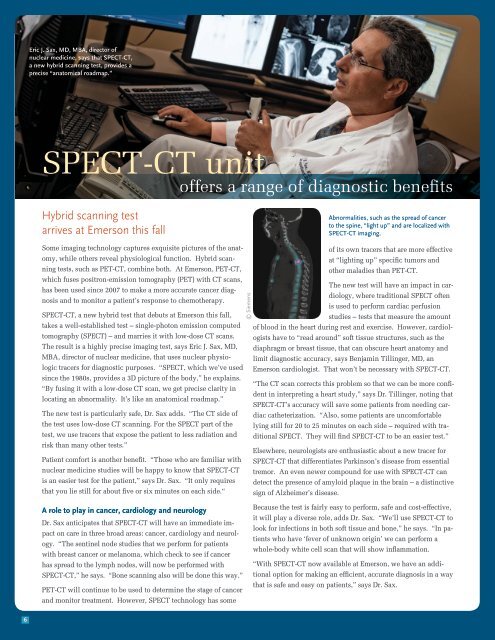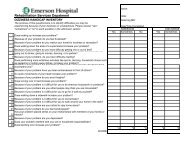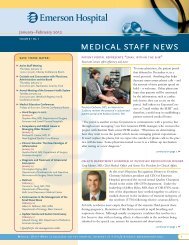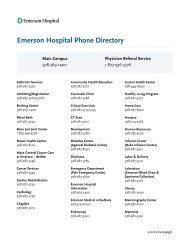Download PDF - Emerson Hospital
Download PDF - Emerson Hospital
Download PDF - Emerson Hospital
- No tags were found...
You also want an ePaper? Increase the reach of your titles
YUMPU automatically turns print PDFs into web optimized ePapers that Google loves.
Eric J. Sax, MD, MBA, director ofnuclear medicine, says that SPECT-CT,a new hybrid scanning test, provides aprecise “anatomical roadmap.”SPECT-CT unitoffers a range of diagnostic benefitsHybrid scanning testarrives at <strong>Emerson</strong> this fallAbnormalities, such as the spread of cancerto the spine, “light up” and are localized withSPECT-CT imaging.Some imaging technology captures exquisite pictures of the anatomy,while others reveal physiological function. Hybrid scanningtests, such as PET-CT, combine both. At <strong>Emerson</strong>, PET-CT,which fuses positron-emission tomography (PET) with CT scans,has been used since 2007 to make a more accurate cancer diagnosisand to monitor a patient’s response to chemotherapy.SPECT-CT, a new hybrid test that debuts at <strong>Emerson</strong> this fall,takes a well-established test – single-photon emission computedtomography (SPECT) – and marries it with low-dose CT scans.The result is a highly precise imaging test, says Eric J. Sax, MD,MBA, director of nuclear medicine, that uses nuclear physiologictracers for diagnostic purposes. “SPECT, which we’ve usedsince the 1980s, provides a 3D picture of the body,” he explains.“By fusing it with a low-dose CT scan, we get precise clarity inlocating an abnormality. It’s like an anatomical roadmap.”The new test is particularly safe, Dr. Sax adds. “The CT side ofthe test uses low-dose CT scanning. For the SPECT part of thetest, we use tracers that expose the patient to less radiation andrisk than many other tests.”Patient comfort is another benefit. “Those who are familiar withnuclear medicine studies will be happy to know that SPECT-CTis an easier test for the patient,” says Dr. Sax. “It only requiresthat you lie still for about five or six minutes on each side.“© Siemensof its own tracers that are more effectiveat “lighting up” specific tumors andother maladies than PET-CT.The new test will have an impact in cardiology,where traditional SPECT oftenis used to perform cardiac perfusionstudies – tests that measure the amountof blood in the heart during rest and exercise. However, cardiologistshave to “read around” soft tissue structures, such as thediaphragm or breast tissue, that can obscure heart anatomy andlimit diagnostic accuracy, says Benjamin Tillinger, MD, an<strong>Emerson</strong> cardiologist. That won’t be necessary with SPECT-CT.“The CT scan corrects this problem so that we can be more confidentin interpreting a heart study,” says Dr. Tillinger, noting thatSPECT-CT’s accuracy will save some patients from needing cardiaccatheterization. “Also, some patients are uncomfortablelying still for 20 to 25 minutes on each side – required with traditionalSPECT. They will find SPECT-CT to be an easier test.”Elsewhere, neurologists are enthusiastic about a new tracer forSPECT-CT that differentiates Parkinson’s disease from essentialtremor. An even newer compound for use with SPECT-CT candetect the presence of amyloid plaque in the brain – a distinctivesign of Alzheimer’s disease.A role to play in cancer, cardiology and neurologyDr. Sax anticipates that SPECT-CT will have an immediate impacton care in three broad areas: cancer, cardiology and neurology.“The sentinel node studies that we perform for patientswith breast cancer or melanoma, which check to see if cancerhas spread to the lymph nodes, will now be performed withSPECT-CT,” he says. “Bone scanning also will be done this way.”PET-CT will continue to be used to determine the stage of cancerand monitor treatment. However, SPECT technology has someBecause the test is fairly easy to perform, safe and cost-effective,it will play a diverse role, adds Dr. Sax. “We’ll use SPECT-CT tolook for infections in both soft tissue and bone,” he says. “In patientswho have ‘fever of unknown origin’ we can perform awhole-body white cell scan that will show inflammation.“With SPECT-CT now available at <strong>Emerson</strong>, we have an additionaloption for making an efficient, accurate diagnosis in a waythat is safe and easy on patients,” says Dr. Sax.6
















